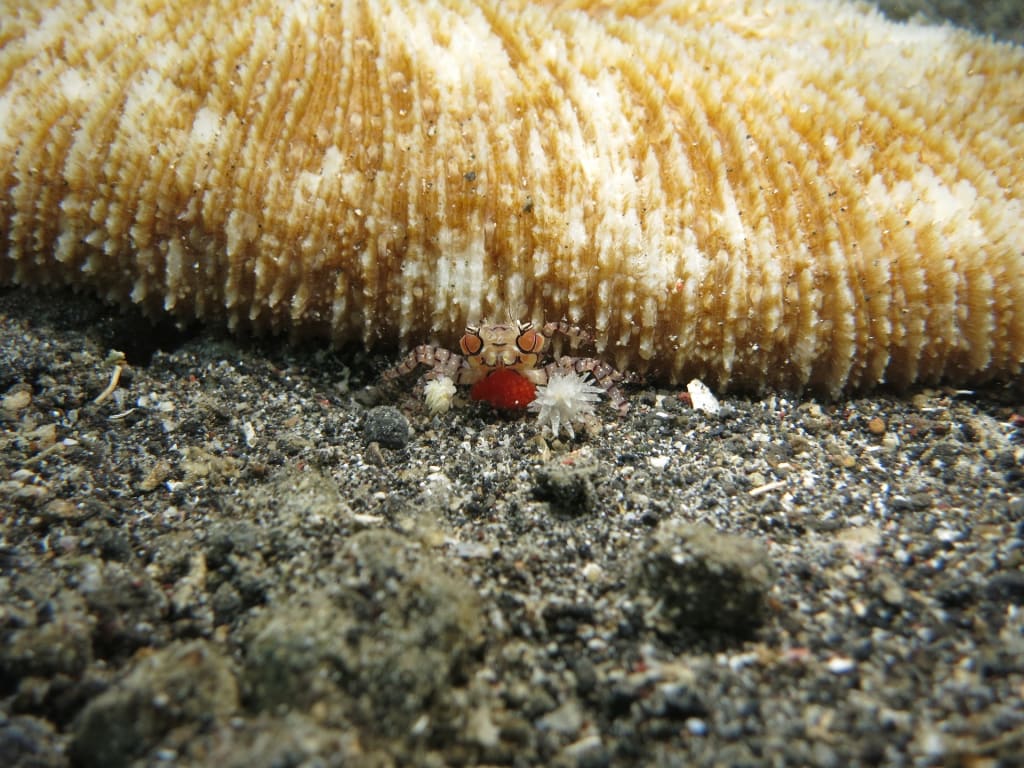The little crab, with its adorable pose holding onto a sea anemone, is simply precious.
The Boxing Crab: A Resourceful Fighter with an Anemone "Glove"

On a coral reef, a crab was leisurely strolling and foraging, completely unaware that a famished little moray eel was covetously eyeing it from the crevices in the rocks nearby. As the moray eel crept closer and closer in the shadow of the reef, the crab realized the danger and it seemed that it could not escape the gaping maw full of sharp teeth. Suddenly, the crab began punching the moray eel with its fists, which were actually two anemones! The moray eel looked left and right, realizing that it seemed unable to bite down and left dejectedly.
In this article, we introduce the "boxer" of the ocean - the boxer crab.
The boxer crab is a general term for a type of crab, also known as pom-pom crab or Hawaiian boxer crab, scientifically named Lybia. They mainly live in the coral reef areas of Southeast Asia and Oceania.
From the name, you might think that the boxer crab is sturdy with large claws, exuding the charm of a heavyweight boxing champion, but you would be very wrong. In fact, the boxer crab is a small type of crab, and the size of an adult crab is only 3-5 centimeters, making it a mini-boxer. As for their claws, they are not larger than those of other crabs of the same size, and may even be smaller.

Without a large body size or big claws, the boxer crab seems to have no advantage compared to its other crab companions. However, it has its own good CP - anemones. As a well-known poisonous species, anemones can always make the vast majority of marine life stay away. The boxer crab chose anemones as its CP to protect itself. The boxer crab lets the anemones attach to its claws, becoming their "boxing gloves". When a predator attacks, the boxer crab bravely fights back. At this time, the anemones also cooperate by waving their tentacles and biting, seizing the opportunity to "poison" the opponent and make it suffer. In fact, sometimes, due to the large amplitude of the boxing movements of the boxer crab, coupled with the long tentacles of the anemones, it looks more like a cheerleader doing a cheerleading routine, which is why the boxer crab is also called the pom-pom crab.
The relationship between the boxer crab and the anemones is a simple symbiotic relationship that involves only food and safety. The anemones fix themselves to the claws of the boxer crab and travel with the crab for free. The boxer crab waves the anemones on its claws when it encounters danger in daily life to scare off enemies, while the anemones can use the food debris from the boxer crab to fill their stomachs. Moreover, after molting, the boxer crab "receives" the anemones back and continues to place them on its claws.
Overall, the boxer crab and sea anemone partnership is a fascinating example of the diverse and intricate relationships that can be found in the marine world.
In this symbiotic relationship, who benefits more? Clearly, it's the small crab, as it holds the initiative in its claws. The anemone, on the other hand, is quite passive, being plundered for food, torn in half by human hands, and forced into asexual reproduction. When enemies approach the small crab, the anemone's reaction is more like, "Oh my gosh, don't use me as a shield! Don't come any closer!" only then to be forced to fire its stinging cells. In fact, the anemone is even sometimes nibbled on by the small crab, leaving its column and pedal disc in a conical shape, much like the crispy shell of an ice cream cone, which is easier to grasp.
We won't even delve into the plight of the anemone, but despite such passivity, it has been mentioned earlier about the benefits it receives from this symbiotic relationship.





Comments
There are no comments for this story
Be the first to respond and start the conversation.